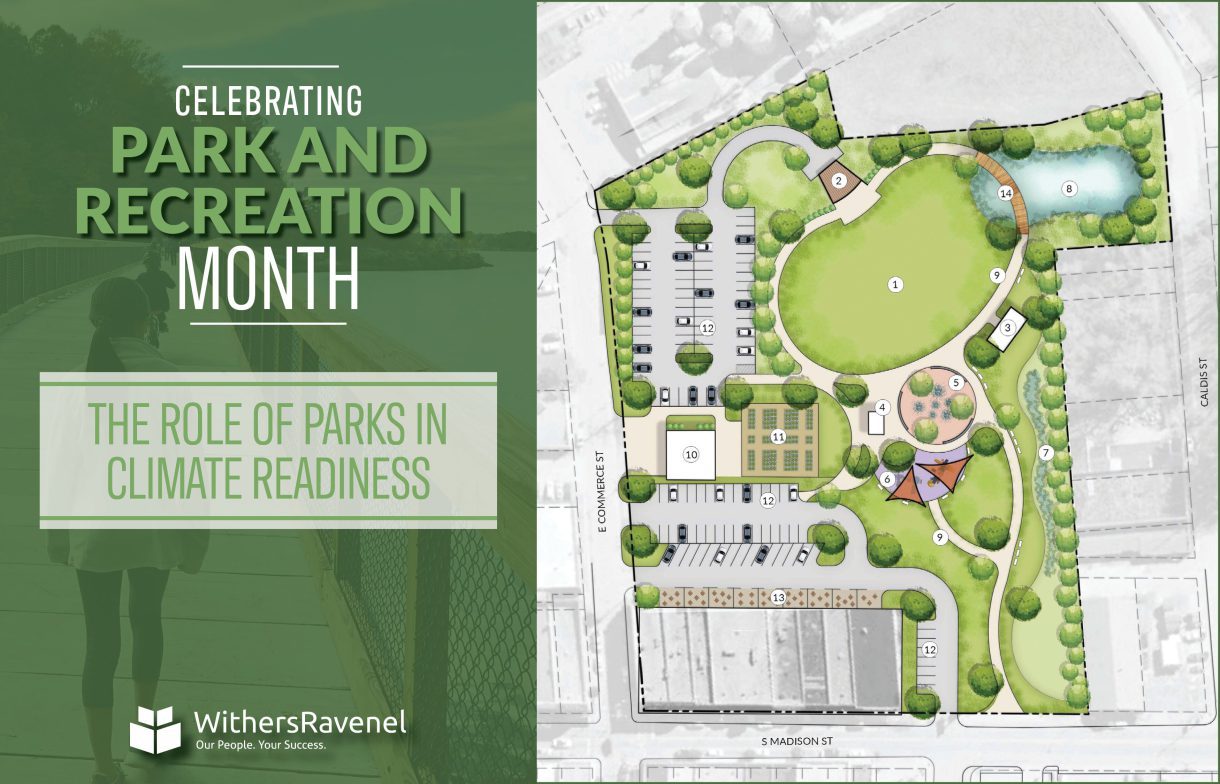
Changing climate patterns influence how we approach various aspects of life as we strive to build resilience against unpredictable, and increasingly intense, weather events.
At WithersRavenel, park projects provide an opportunity to strengthen a community’s climate resilience. In addition to other aspects of park design such as accessibility, inclusivity and protecting natural resources, incorporating increased capacity to accommodate storm events, provide habitat and reduce carbon footprint have become a priority and shape design.
The American Society of Landscape Architects (ASLA) recognizes climate change in its strategic plan and landscape architects are leading stormwater resiliency planning and design. Climate resilient design is not only applicable to park design, but every project and at every scale from community planning to urban spaces,according to Brian Starkey, WithersRavenel’s Director of Parks and Recreation. Our landscape architects are well-equipped to lead and take on the challenge working collaboratively with our environmental and storm water engineers.”https://withersravenel.com/legacy-of-olmsted-wrs-brian-starkey-reflects-on-his-connection-to-olmsteds-work/
Duffyfield Community Park
One recent project where this collaboration has been successful is Duffyfield Community Park in the City of New Bern.
The Duffyfield project was initiated to address stormwater management issues in the community but turned into something much more. We saw an opportunity to provide a community space in conjunction with the objective to reduce the risk of periodic flooding in this neighborhood and incorporated a park space that provides opportunities for education, play, public art and gathering,Brian added. We are creating habitat with these stormwater management facilities, and a community space at the same time.
Having completed the master plan, WithersRavenel is developing construction plans for the project. These plans will detail constructed stormwater wetlands as well as park spaces and facilities.
The need for resilience is not confined to coastal North Carolina, as the intensity and frequency of storms and the damage done by them can be seen across the state.
Advocating for sustainable solutions and making resiliency a program element, and a project objective, is something that we are now doing that 10 years ago we didn’t think much about,Brian said.
Brian adds that in addition to creating green space, habitat, and places for people to interact with nature, the importance of resiliency is a more recent design consideration. The goal of resiliency now informs and shapes park design. In park planning and design the marriage between general park design and mitigating stormwater events is an easy one.Brian said.
But do these measures come at a cost to the aesthetics of parks and visitor’s experience? Brian believes that designing for resiliency does not require compromise when it comes to aesthetics or the experience.
Our aspiration is to create experiences that connect park visitors with nature. In some ways, the experience can be enhanced by creating different habitats and a variety of landscapes which are made possible by low-impact development stormwater management solutions,he said.
The collaboration between landscape architects and the stormwater management team at WithersRavenel from the start of the project ensures that opportunities for incorporating resilient solutions are identified early and bring together science and art, resulting in comprehensive solutions.”
Other resiliency-based design measures that are integral to the WithersRavenel team’s process include curating a native plant palette that will contribute to the local ecology, ensuring biodiversity, improving water quality, and supporting pollinators as well as the selection of hardscape materials and site amenities that are sustainably manufactured.
Lewis Smith Property
Another project where a primary aim is to build resiliency against frequent and serious flooding is in the City of Whiteville. The City recently approved the Master Plan for the redevelopment of the Lewis Smith Property in downtown.
The plan converts what was a completely impervious site into a green community space.
Previously home to a shopping center, the site lies within the floodplain. Over the past few years, the site and surrounding properties have been flooded on numerous occasions. One of the primary objectives of the design is stormwater resilience. The master plan illustrates a constructed wetland, a major bioswale, and a lot of green space that will be shaped to temporarily hold water and allow it to infiltrate.When dry, this area will serve as the lawn for an outdoor performance space. The park also features native plant species and calls for permeable paving in parking areas and for other hard surfaces.
Funding resiliency
In support of the project WithersRavenel’s Funding Department is working with the City to identify a funding pipeline for the project including state and federal sources.
In particular, WithersRavenel has worked with the state’s Southeastern Economic Development Commission (SEDC) that represents 12 counties, where Funding Specialist Bob Taylor has assisted communities in the region through a Disaster Recovery Coordination contract. The scope of disaster recovery coordination included securing funding for communities to recove from devastating damage from Hurricanes Matthew and Florence with a focus on building resilience. Successful projects have ranged from critical water and sewer infrastructure improvements to performing arts facilities, utility vehicles, and even additional staffing resources at local governments. Resiliency efforts in communities such as Hertford and Oxford have sought to leverage federal resiliency funding programs such as FEMA’s Building Resilient Infrastructure and Communities (BRIC) with state-funded resources such as the Golden LEAF Foundation’s Flood Mitigation Program that will support community-wide vulnerability assessments.
As with every project, be it parks, utilities, or transportation, WithersRavenel’s multidisciplinary capabilities allow us to provide holistic solutions to our clients.
Do you want to put WithersRavenel’s parks and recreation and landscape architecture professionals to work for you? Contact Parks and Recreation Director Brian Starkey at (919) 238-0305 or bstarkey@withersravenel.com for information.
